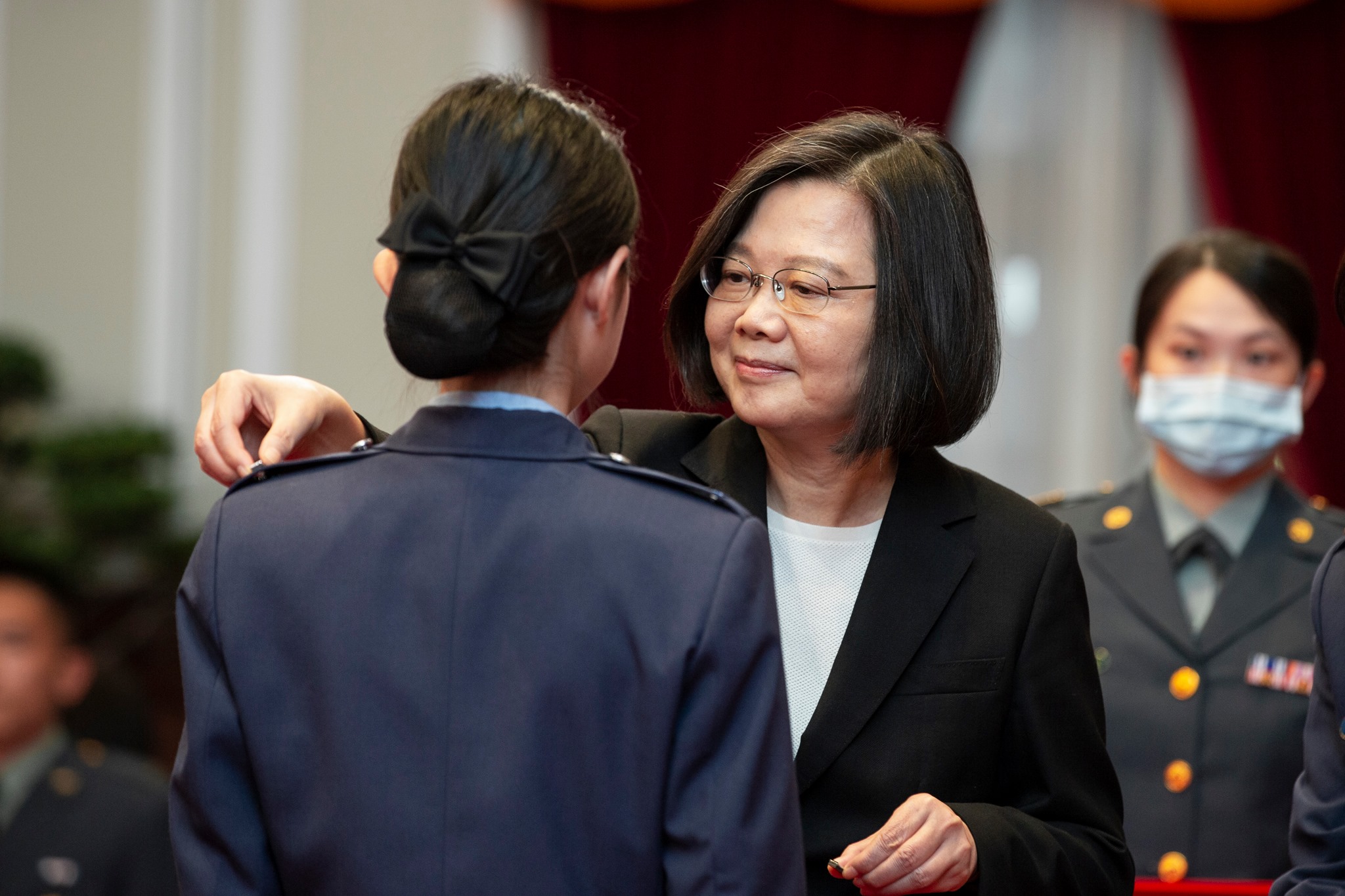Despite claims by Chinese hawks that the live-fire military exercise is aimed at Taiwan and that the aircraft carrier ‘Liaoning’ could be involved, there is every indication that the drills are little more than a routine artillery exercise.
The Chinese military will hold live-fire exercises in the Taiwan Strait today (Wednesday) as President Tsai Ing-wen is on her first state visit to Africa. The announced maneuvers have sparked a frenzy of reporting — and hyperbole — in international media, which as always are on the lookout for high drama.
Chinese authorities have revealed very little about the nature of the exercise since the announcement. A statement by the Fujian maritime safety administration only indicated that the maneuvers are to commence at 8am and end at midnight. The drills will take place in waters off Quanzhou, Fujian Province, across from Taiwan.
Despite the dearth of information, international media have depicted the drills in the most dramatic of terms: as “the first live-fire exercise in the Strait” since the 1995-6 Taiwan Strait Missile Crisis, as occurring “amid rising tensions in the Taiwan Strait,” or as “contributing to tensions in the Taiwan Strait.”

Zone of restriction off Quanzhou, Fujian Province (map: CNA)

And to help exacerbate the matter, Chinese commentators, along with the usual state propagandists, provided all the sound bites necessary to create an atmosphere of fear and crisis. The Global Times, a sensationalist Chinese Communist Party (CCP) mouthpiece well known for carrying the views of Chinese hawks, led the charge on April 16 with an article titled “Live-fire drills to check ‘Taiwan independence’” and sub-headed “Provocations by Taiwan’s leaders, others result in mainland’s stern warning.”
In it, Ma Xiaoguang, a spokesperson for the State Council’s Taiwan Affairs Office (TAO), is paraphrased responding to a question by a journalist (very likely staged) that China is “firmly against Taiwan independence” and that “We would like to reaffirm that we have strong determination, confidence and capability to destroy any type of ‘Taiwan independence’ scheme in order to safeguard the country’s sovereignty and territorial integrity.” The vagueness of the generic answer is very telling, leaving itself open to interpretation and seeming to support the view, provided in the form of a leading question by the reporter, that the exercises are indeed conducted to send a warning to Taiwan and to deter Taiwanese independence.
A day earlier, TAO director Liu Jieyi said the live-fire drills were “an action to safeguard the sovereignty and territorial integrity of our motherland.” As indeed is very single military exercise held by any military on the face of the planet.
As always, comments by TAO officials leave much to interpretation. And when the media over-interpret what was said by painting an atmosphere of crisis, Chinese officials will certainly not do anything to disabuse them of such views. And why would they, if the media are inadvertently doing propaganda on Beijing’s behalf, in the process contributing to pressure on Taiwan (and in this case, taking attention away from President Tsai’s state visit to Africa)?
Quoting the hawks
After the TAO officials came the Chinese military commentators.
Song Zhongping, a military commentator for Hong Kong-based Phoenix TV, as quoted by AFP: “The mainland [China] must create military pressure to let the other side know that no matter whether it happens gradually or they really declare independence, it is totally unacceptable.” And he added that China’s sole aircraft carrier, the Liaoning, was “likely” to participate in Wednesday’s exercises, because “has a lot of advantages for resolving the Taiwan problem” and “can effectively acquire control of the airspace, and even effectively block the US-Japanese alliance’s strategy for intervening in China’s plan to settle the Taiwan issue.”
The same Song is quoted in the Global Times: “The drill comes as the Taiwan authority has been obstinately promoting ‘Taiwan independence,’ especially considering that Taiwan leader [President] Tsai Ing-wen and the island’s [Taiwan] administrative head [Premier] Lai Ching-te keep spreading the idea.” And he added: “The mainland needs this targeted drill to punish the two.” And: “The focus of the upcoming drill will be long-distance attacks and amphibious landing operations, which worries Taiwan the most.”
Also quoted in the Global Times is Lü Cuncheng, a research fellow at the Institute of Taiwan Studies of the Chinese Academy of Social Sciences: “The US has been containing China on the Taiwan question, and ‘Taiwan independence’ forces have been touching the bottom line of the one-China principle […] The drill is necessary for the development of the military of the Chinese mainland […] The Chinese mainland should show its confidence and determination to hinder any ‘Taiwan independence’ scheme.”
Whether Song (retired) and Lü (civilian) speak on behalf of the People’s Liberation Army (PLA) or have special channels to the decision-making apparatus is highly questionable. Much of what they provide is speculation and ultra-nationalist hyperventilation, as the Global Times is wont to publish. More worrying is the fact that such commentators are taken seriously by international media, or are seen as spokespersons for the CCP and the PLA.
Calm response
Meanwhile, Taiwan’s Ministry of National Defense (MND) is not panicking, nor is the Taiwanese public, or the stock market. On Monday, MND described the PLA drills as a “routine artillery drill” and reassured the public that it had the situation under control. It also described the exercise as a form of psychological warfare.
For its part, Taiwan’s National Security Bureau said the scale of the military exercise was “roughly the level involving a battalion,” and was to take place at the Shishi target area, which has existed since 2007.
Contrary to what some media have reported, this is not the first live-fire military exercise to be held in the Taiwan Strait. In September 2015 — when the “Beijing-friendly” Ma Ying-jeou of the Kuomintang (KMT) was in office — the PLA held a three-day live-fire drill during which ground forces in Fujian Province conducted regular artillery firings in an area about 14 nautical miles off Weitou. That exercise overlapped with the last day of the annual live-fire Han Kuang exercises in Taiwan.
Other live-fire exercises by the PLA near the Taiwan Strait have been held in recent years. In July 2012, the PLA Navy (PLAN) conducted a five-day live-ammunition naval exercise in waters off Zhoushan and Taizhou, Zhejiang Province. If hawkish commentators wanted to do so, they could also depict such maneuvers as aiming to deter Taiwan independence forces.
As expected, this appears to be a routine artillery drill. According to Taiwanese and military media reports this morning, the Liaoning is still involved in exercises in the South China Sea and unlikely to be dispatched to the Taiwan Strait to take part in the drills off Fujian. Reports, citing military sources, also indicate that there has been no increase in the number of troops in the area, and that no warships or fighter aircraft have been mobilized for the exercise.
The main reason why the Taiwanese are not panicking, and why much of the international media reporting on today’s military exercises completely misses the mark, is that they have gotten used to this kind of propaganda and therefore can easily shrug it off. Not only does this strategy fail to coerce the Taiwanese public or make them less supportive of the liberal-democratic way of life they cherish, it actually backfires, compounding their alienation from China. Moreover, the growing frequency of PLA live-fire exercises and passages near Taiwan — many of them in the West Pacific — in recent years, has, ironically, diluted the effectiveness of such propaganda efforts. Thus, if the aim is to spark a panic in Taiwan, Beijing is failing miserably.
It needs to be said, as well, that a sizeable share of recent PLA activity near Taiwan — transits in the Taiwan Strait, the Bashi Channel between Taiwan and the Philippines, and the Strait of Mikayo between Taiwan and Japan — has not been primarily aimed at Taiwan but is rather part of the natural progression of a military that is expanding its presence beyond the “first island chain.” This includes the East and South China Sea, as well as the West Pacific. Therefore, while propagandists may want to portray every military exercise as action targeting or “warning” Taiwan, the psychological impact is in reality collateral, secondary to the principal objectives of the said maneuvers.
As expected, this appears to be a routine artillery drill. According to Taiwanese and military media reports this morning, the Liaoning is still involved in exercises in the South China Sea and unlikely to be dispatched to the Taiwan Strait to take part in the drills off Fujian. Reports, citing military sources, also indicate that there has been no increase in the number of troops in the area, and that no warships or fighter aircraft have been mobilized for the exercise.
At this writing, the official PLA website has yet to publish any pictures of the ongoing exercises and has no article on the subject.
Taiwan certainly cannot afford to take PLA exercises lightly, and continues to pay close attention to them. But overreacting, or getting carried away in the media frenzy, would be a terrible mistake.
You might also like
More from Cross-Strait
The Making of ‘Insidious Power: How China Undermines Global Democracy’
A new book released on July 30 takes a close look at the agencies and mechanisms of CCP 'sharp power' …
Beijing Was Cooking the Frog in Hong Kong Well Before the National Security Law
Well before the coming into force of the NSL on July 1, the special administrative region had already become a …
As Coronavirus Crisis Intensifies, Beijing Continues to Play Politics Over Taiwan
With a major epidemic on its hands, the Chinese government has not ceased its political warfare activities against Taiwan. It …









